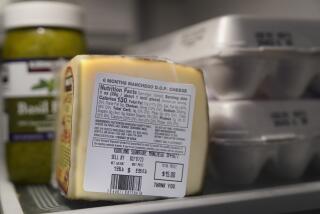Labels From Fruit Crates Relay History
- Share via
Question: How far back do genuine fruit-crate labels go? I’m attempting to judge the value of some of the older ones in my collection.--E.A.
Answer: The story goes: Back in the 1880s, Southern California growers were facing stiff competition from foreign fruit growers. So the local growers decided that they would attempt to promote their products in a colorful way that would attract the eye of both distributors and consumers. Hence, the start of a collectible that has become very popular in recent years.
Finding original California fruit-crate art from the 1880s may be difficult, however; undoubtedly, they will be more expensive than labels of more recent vintage.
In attempting to evaluate this art form in terms of age, you should know when fruit-crate-label art went the way of the dodo bird. That was in the 1940s, when producers began switching over from wooden crates to cardboard boxes.
Collectors like to look for early California lithographers when they add to their collection. The printers also can provide clues to age and value. For example, among the most sought-after labels are those produced by the Mutual Litho Co., which had its plant in San Francisco. The 1906 San Francisco earthquake promptly sounded that firm’s death knell, and today, Mutual Litho labels are hard to find.
Collecting fruit-crate labels provides an interesting glimpse into California history. The collector can readily spot changing customs, styles and the like. And, unlike some other collectible categories, it is not very expensive for beginners because many colorful fruit-crate labels can still be bought for only a few dollars apiece.
Q: I have some old cowboy hats that were left to me by my father who used to own a ranch in Arizona. How can I date these hats so I can get a handle on what they might be worth?--L.D.
A: Collectors who specialize in cowboy gear tell us that it’s very difficult to determine a hat’s age.
Becoming familiar with various manufacturers and their years of production would help. So would doing some homework on how styles changed over the years. The famous ten-gallon hat, for example, became famous after the turn of the century and was seen all over the West for decades.
Your best bet might be to pick out a couple of top Western-style hat distributors and let them eyeball your collection. They might be able to give you some pointers.
Q: Did you once print an association for bell collectors? My wife and I have an extensive collection of doorbells and would like the organization’s address.--C.H.
A: The only group we listed that we believe has a national following was the American Bell Assn., Route 1, P. O. Box 286, Natronia Heights, Pa. 15065.
Doorbells, of course, are just one area of this popular collectible, which keeps thousands of individuals busy across the nation. Other areas of specialization involve collecting sleigh and school bells, glass bells and intricately designed or elaborately painted bells, such as might be found with foreign-produced items of the last century.
Collecting bells can be expensive. We’re talking about spending $100 or more for a particular bell. Since much of the price is a product of age and producer, the beginner should do a lot of reading and talking with other collectors before plunging into a fairly complex area. But the field does appear to have an active market of buyers and sellers.
Ronald L. Soble cannot answer mail personally but will respond in this column to questions of general interest about collectibles. Do not telephone. Write to Your Collectibles, You section, The Times, Times Mirror Square, Los Angeles 90053.
More to Read
Eat your way across L.A.
Get our weekly Tasting Notes newsletter for reviews, news and more.
You may occasionally receive promotional content from the Los Angeles Times.










